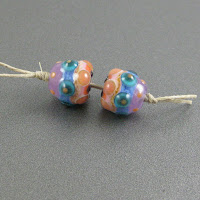This week I have been focused on using some of the new transparents and the new lapis-hued semi-opaque colour called Blueberry Muffin.
Candlelight (CiM322) is a very pale yellow transparent colour. It comes out very true to the colour of the rod, although while you are working it it blushes a deep yellow. I wasn't exactly sure what I was going to get when they went into the kiln and was thrilled when they came out such a unique and useful colour..
This colour works beautifully without any bubbling or scumming or fuss. I found the melted ends liked to crack off when reintroducing them to the flame, but that happens with many of the transparent colours from all the manufacturers.
Here you can see that Candlelight is substantially paler than Effetre Straw Yellow. I am excited about this colour and want more of it, because it has so much potential for fun.
One of the tests that I like to do with pale and medium transparents is to see what happens to silver foil when I use them to encase the foil. When I do this test, this is exactly the reaction that I am hoping to find - check out how golden and beautiful the silver foil went under Candlelight. This means that Candlelight will also make wicked silver glass frit stringer.
Other colours that do this to silver foil include Effetre Straw Yellow, Effetre Light Brown Transparent, Effetre Pale Green Apple, Effetre Kelp, and CiM Mojito. I am sure I am forgetting some in that list, and there are colours I have not tested yet, so that list is not definitive.
These beads all contain Candlelight:
Goldfish (CiM218) is a slow-to-strike transparent orange that, when fully struck, is pretty much identical to Clockwork. I found this colour slow to develop in the flame, so if you want the deep, bright orange that it can become, you will want to use it in larger or more complex beads that have longer working time so that the beautiful colour has time to develop. I would not say that this colour is difficult to strike, but it does take some time and patience. Like Candlelight, Goldfish is a transparent colour without bubbliness, scumminess or other workability problems. Like Clockwork, this orange opacifies as it strikes, and looks very opaque in thick layers when fully struck.
Understruck Goldfish ranges from yellow to golden orange, and I sort of appreciate the variation you can get from it. All of the other oranges that I've used (pictured below) develop colour much more readily, which can be nice but does not offer the flexibility that Goldfish does, where you can strike it as much or as little as you want to get different shades of orange.
Here you can see Goldfish with Effetre Orange, Vetrofond Orange, and Clockwork. The three other oranges all strike much more quickly than Goldfish.I like all of these colours for different reasons, and isn't it nice that they are so different from each other and differently useful that we can totally excuse owning all of them?
These beads all contain Goldfish. As you can see, I was much more successful striking it in these 'real' beads than I was in the test cylinder above because the working time was substantially longer and the beads all had more heating/cooling cycles as I decorated them.
Firedragon (CiM124) is a beautiful orange-red transparent, a few shades warmer and lighter than Sangre. I found this colour equally nice to use as I did Candlelight and Goldfish. It fills a bit of a gap in my palette, since there really are no other transparent colours that I know of that are on the cusp of orange and red the way this one is.
Blueberry Muffin (CiM633) is supposed to be the same hue as CiM Lapis. It seems lighter in most of my beads because I have used it in thin layers over light colours.
This colour is pleasantly reactive, and I absolutely think that CiM should keep making it. It's like a deep, dense ink blue with fun reactive potential and I am very excited about all the crazy things we will do together.
If I could change anything about this colour it would be to make it more translucent. Even in thin layers, it can look almost opaque. I wonder what it would be like as a Misty Opal?
That's all for this week! I am not sure what I'll post next because there are still so many delectable choices, but I will be back next week with more colour news.








































